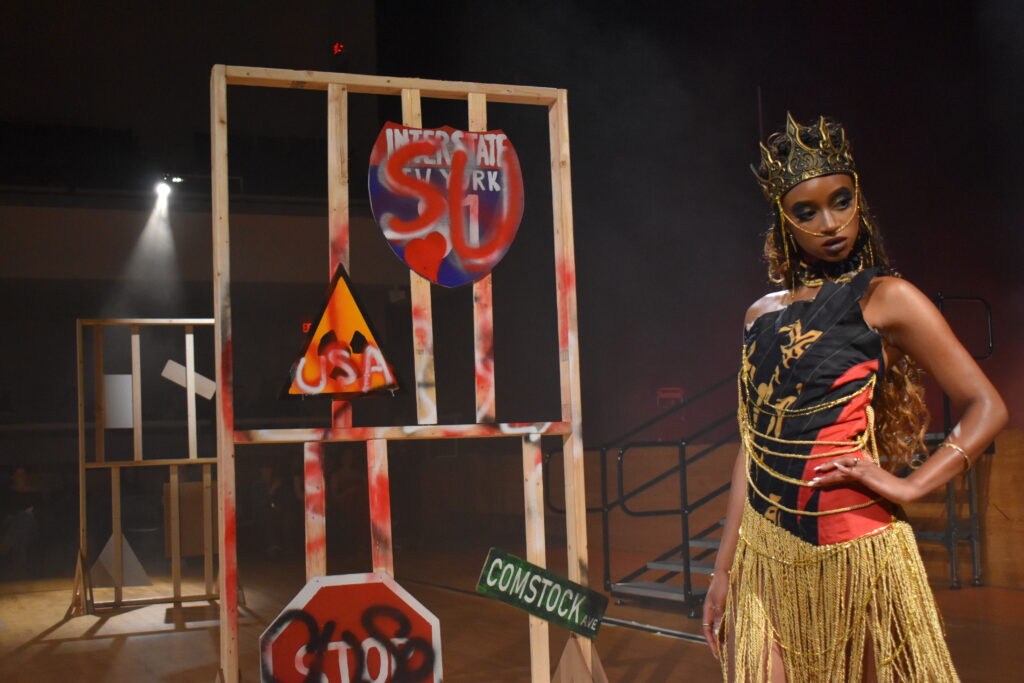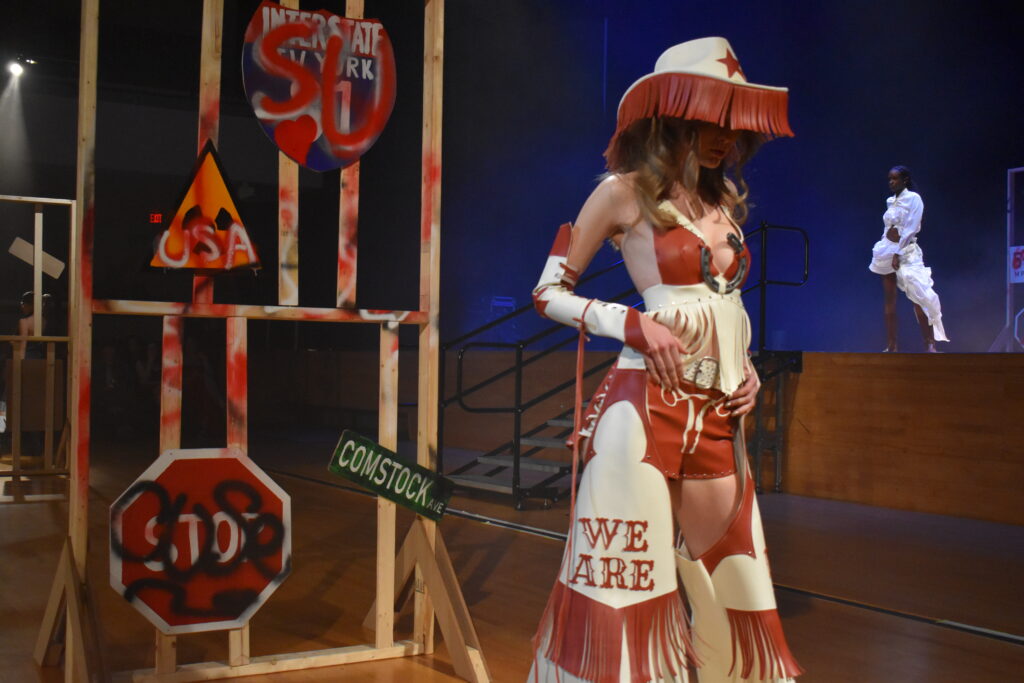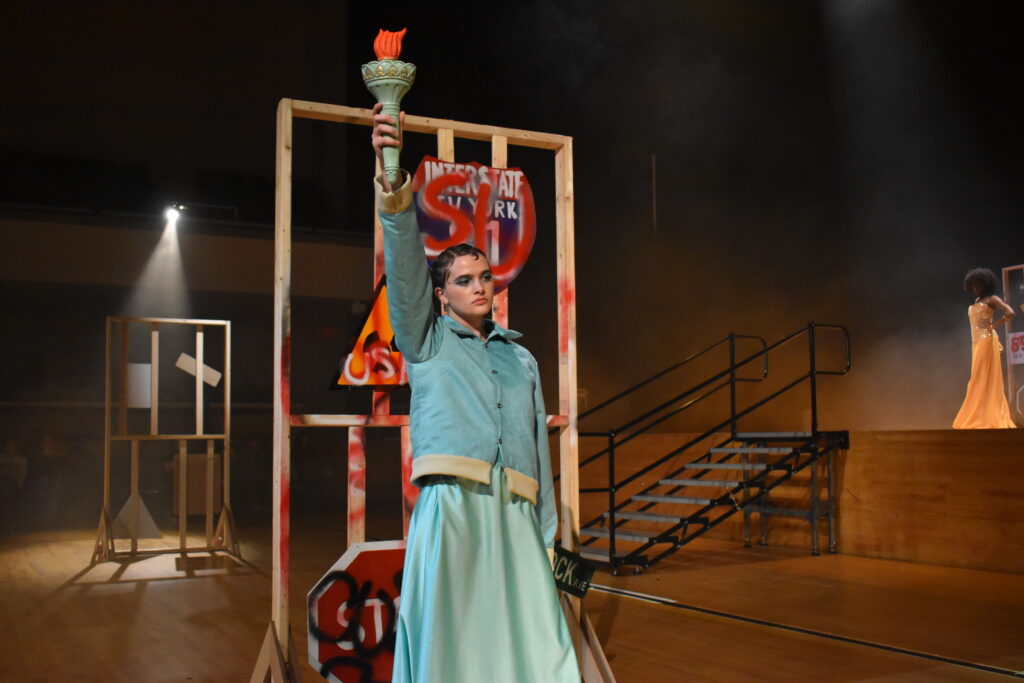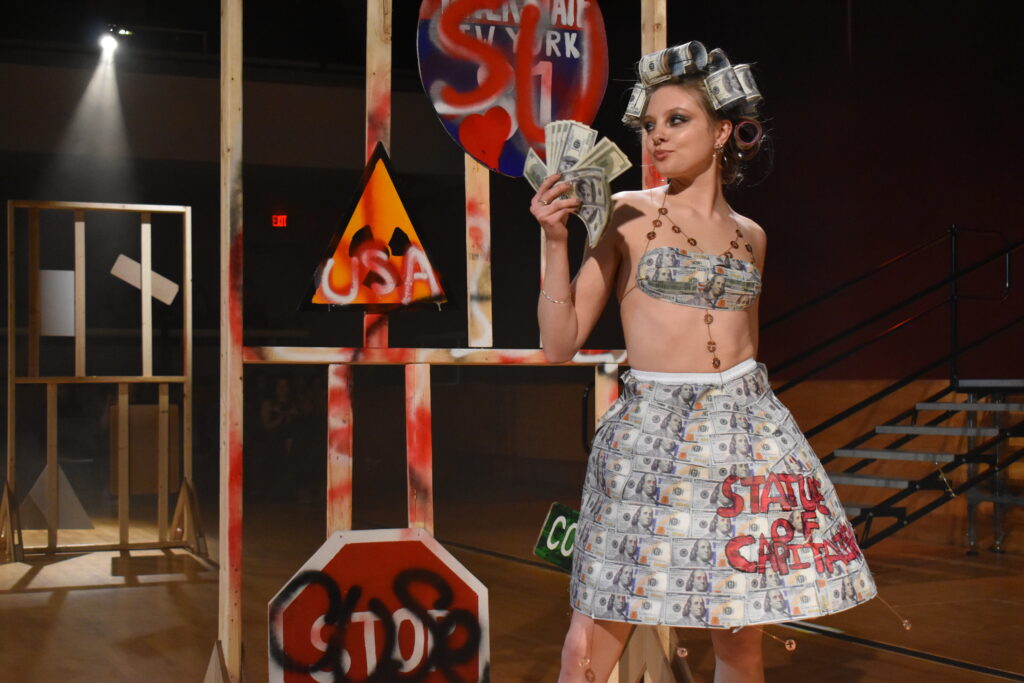FADS redefines the American Dream with handmade student designs
Handmade FADS designs redefines the American Dream
The Fashion and Design Society’s show served not only as a space for creative expression, but as a platform for political commentary.

A thin layer of smoke billowed through the Goldstein Auditorium as the stage lights dimmed. Arianna Oladapo glided down the stage stairs, greeting the audience with a contemporary dance to a remix of the national anthem. The crowd fell silent. Her long, white, flowy skirt flared with each spin.
Carter Moreland emerged from the side stage in a classic Hampton’s summer ensemble: white khaki shorts paired with a loose Oxford shirt and a sports coat. The solo became a duet. Despite the dancers’ simple attire, the introduction signaled the beginning of a fashion show that was anything but traditional.
Syracuse University’s Fashion and Design Society (FADS) hosted its semi-annual fashion show on Saturday, Nov. 15, at Goldstein Auditorium. The theme, “American Dream re: Fashioned,” challenged both designers and audience members to redefine their understandings of the American Dream.
FADS Vice President Grace Kentrotas said this year’s theme was nothing like they’ve done before. In past semesters, the themes were more abstract. This year pivoted, shifting to something everyone could relate to, she said.
Designers and audience members had unique interpretations of the theme based on their own experiences.
“Some people believe in (the American dream), others don’t, or others have completely reinvented the meaning for themselves,” Kentrotas said.
The dance introduction was also a first for FADS. Kentrotas said it was important to the choreographer, Amaya Marie, to feature dancers who are people of color.

“[The dance] set the tone for the show and kind of said straight from the beginning that the American Dream is something different for everyone,” Kentrotas said. “And I think especially what it’s meant for Black people in America.”
The student-produced show delivered handmade designs worn by diverse models. The fashion looks themselves were not only iconic, but thought-provoking.
Fashion design sophomore Madelyn Wolcott modeled one of her own designs. Her entirely leather ensemble was more than a testament to her design skills. It was a bold statement on reproductive rights.
The phrases “Laws off our bodies” and “We are not livestock” were written across Wolcott’s fringe chaps. She completed her look with a matching fringe cowboy hat.

“When I heard the theme ‘American Dream re: Fashioned’ and talking about critiquing and challenging that, thinking in my experience as a woman, to me that means having equal access to freedom and independence through total bodily autonomy,” Wolcott said.
Common patterns associated with Americanism had their moment. Gingham, camouflage and denim all made an appearance on the runway, but most designs weaved traditional American symbols with political commentary.
The pieces also featured a heavy presence of props and trending styles, such as lace and polka dots. One student modeled a Statue of Liberty-inspired look with a teal torch in hand. A duct tape briefcase with “Inside: Burnout” across the front complemented a traditional corporate America look.
Communications design junior Priya Shaw wore a skirt and bra set made of fake 100-dollar bills. Bold, red bubble letters, “State of Capitalism,” lined the skirt hem. Shaw threw bills as she walked.

Some designers chose to incorporate their own cultural identities into their designs. FADS President, Jada Williams, incorporated the Black American Heritage flag into her design. Kadiatou Bah modeled the single shoulder top and skirt look. The skirt made of tassels swayed as she strutted across the floor. A gold and black crown sat atop her head.
Other designers pulled from themes of the immigrant experience, showcasing their cultural pride through fashion.
The show’s set design offered another layer of interpretation of the American Dream. Handmade wooden frames covered in graffitied street signs lined the stage and floor. The set design not only offered an eye-catching backdrop for the models, but redefined traditional blue-collar associations with the American Dream. One wooden frame showcased SU pride, featuring Comstock Ave and Interstate I-81 street signs with “SU” and “Cuse” graffiti tags.

The entire show was interactive to its core. Audience members played a role in the show, dressing in their own takes on the American Dream. Guests wore leather, fringe, tall boots and the occasional cowboy hat, blurring the lines between the show and the audience.
The show concluded with an eruption of clapping and cheering. Audience members shouted out their friends by name. Models ran to their supporters in the crowd after their final walk. The show marked a night of reclaiming American identity through handcrafted fashion.
“Now is a really important time to have these conversations that were brought up by these designs,” Wolcott said. “I think a lot of the designers and models, too, felt very empowered by being able to sort of channel a lot of the anger we’ve been feeling with the current state of the country through our art.”
